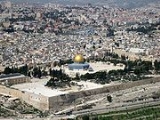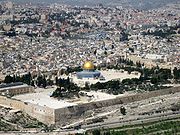
Gates of the Temple Mount
Encyclopedia

Temple Mount
The Temple Mount, known in Hebrew as , and in Arabic as the Haram Ash-Sharif , is one of the most important religious sites in the Old City of Jerusalem. It has been used as a religious site for thousands of years...
, located in Jerusalem, can be accessed through eleven gates, and contains a further six sealed gates.
Open gates
The following is an anti-clockwise list of gates which open onto the Temple Mount.Gate of the Tribes
The Gate of the Tribes, , is located at the north-eastern corner of the Temple Mount.Gate of Remission
The Gate of Remission, , is located on the north side.Gate of Darkness
The Gate of Darkness, , is located on the north side.Gate of Bani Ghanim
The Gate of Bani Ghanim, , is located on the north-western corner.Council Gate
The Council Gate, , also known as the Inspector's Gate, is located on the western side.Iron Gate
The Iron Gate, ) is located on the western side, near the Little Western WallLittle Western Wall
thumb|rightThe Little Western Wall, also known as HaKotel HaKatan and the Small Kotel, , is a Jewish religious site located in the Muslim Quarter of the Old City of Jerusalem near the Iron Gate to the Temple Mount. The wall itself dates from the Second Temple period,...
.
Cotton Merchant's Gate

Mamluk
A Mamluk was a soldier of slave origin, who were predominantly Cumans/Kipchaks The "mamluk phenomenon", as David Ayalon dubbed the creation of the specific warrior...
Sultan ibn Kalaoun. Since this site is the closest a person can get to the Foundation Stone without setting foot on the mount itself, the gate was a popular place of prayer for Jews during the 19th century.
Ablution Gate
The Ablution Gate, , is located on the western flank.Tranquility Gate
The Tranquility Gate, , is located on the western side.Chain Gate
The Chain Gate, , located on the western flank may have been the location of the Kiponos Gate which stood during the Second TempleSecond Temple
The Jewish Second Temple was an important shrine which stood on the Temple Mount in Jerusalem between 516 BCE and 70 CE. It replaced the First Temple which was destroyed in 586 BCE, when the Jewish nation was exiled to Babylon...
period.
Moroccans' Gate
The Moroccans' Gate, Mugrabi Gate or Gate of the Moors, , is located on the western flank. Over the years, the external façade of Barclay's Gate was covered and the ground outside the Temple Mount was raised many meters above the lintel of the gate. At some stage, probably in the 12th century and maybe even later, a new gate called Bab al-Magharbeh was installed in the Western Wall above the level of the Barclay Gate. It was named after the residents of the adjacent neighborhoodMoroccan Quarter
The Moroccan Quarter or Mughrabi Quarter was an 800-year old neighborhood in the southeast corner of the Old City of Jerusalem, bordering on the western wall of the Temple Mount on the east , the Old City walls on the south , the Jewish Quarter to the west, and the Muslim Quarter to...
, who had come to Jerusalem from Morocco
Morocco
Morocco , officially the Kingdom of Morocco , is a country located in North Africa. It has a population of more than 32 million and an area of 710,850 km², and also primarily administers the disputed region of the Western Sahara...
in the days of Saladin
Saladin
Ṣalāḥ ad-Dīn Yūsuf ibn Ayyūb , better known in the Western world as Saladin, was an Arabized Kurdish Muslim, who became the first Sultan of Egypt and Syria, and founded the Ayyubid dynasty. He led Muslim and Arab opposition to the Franks and other European Crusaders in the Levant...
. This gate is open to this day and is the only entrance to the Temple Mount for non-Muslims.
In 2007, after a landslide two years earlier made the earthen ramp leading to the Mugrabi Gate unsafe and in danger of collapse, the Israel Antiquities Authority started work on the construction of a temporary wooden pedestrian pathway to the Temple Mount.
Golden Gate
The Golden Gate, , , located on the eastern wall of the Temple Mount was probably built in the 520s CECommon Era
Common Era ,abbreviated as CE, is an alternative designation for the calendar era originally introduced by Dionysius Exiguus in the 6th century, traditionally identified with Anno Domini .Dates before the year 1 CE are indicated by the usage of BCE, short for Before the Common Era Common Era...
, as part of Justinian I
Justinian I
Justinian I ; , ; 483– 13 or 14 November 565), commonly known as Justinian the Great, was Byzantine Emperor from 527 to 565. During his reign, Justinian sought to revive the Empire's greatness and reconquer the lost western half of the classical Roman Empire.One of the most important figures of...
's building program in Jerusalem, on top of the ruins of an earlier gate in the wall. An alternate theory holds that it was built in the later part of the 7th century by Byzantine
Byzantine Empire
The Byzantine Empire was the Eastern Roman Empire during the periods of Late Antiquity and the Middle Ages, centred on the capital of Constantinople. Known simply as the Roman Empire or Romania to its inhabitants and neighbours, the Empire was the direct continuation of the Ancient Roman State...
artisans employed by the Umayyad
Umayyad
The Umayyad Caliphate was the second of the four major Arab caliphates established after the death of Muhammad. It was ruled by the Umayyad dynasty, whose name derives from Umayya ibn Abd Shams, the great-grandfather of the first Umayyad caliph. Although the Umayyad family originally came from the...
khalifs. It has two vaulted halls which lead to the Door of Mercy, Bab al-Rahma, and the Door of Repentance, Bab al-Taubah.
Single Gate
The Single Gate is located along the southern wallSouthern Wall
The Southern Wall is a wall at the southern end of the Temple Mount and the former southern side of the Second Temple in Jerusalem. It was built during King Herod's expansion of the Temple Mount platform southward on to the Ophel.-Construction:...
. It once led to the underground area of the Temple Mount known as Solomon's Stables
Solomon's Stables
Solomon's Stables or Marwani Mosque is an underground mosque some 600 square yards beneath al-Aqsa Mosque in Jerusalem...
.
Huldah Gates

Crusades
The Crusades were a series of religious wars, blessed by the Pope and the Catholic Church with the main goal of restoring Christian access to the holy places in and near Jerusalem...
tower and only part of the right gate can be seen. The only original part of the gate still visible is the lintel and even this is no longer in its original position. When first laid it was 11 metres above the doorstep.
The set on the right is a triple-arched gate, known as the Triple Gate. Each of the gates once led into an aisle of a passageway leading from the gate into the Mount, and to steps leading to the Mount's surface.
The fact that the original entrance gateways still exist reflects an ancient promise cited in Shir ha-Shirim Rabbah
Shir ha-Shirim Rabbah
Shir ha-Shirim Rabbah is a Haggadic midrash on Canticles, quoted by Rashi under the title "Midrash Shir ha-Shirim" . It is called also "Agadat Ḥazita", from its initial word "Ḥazita" , or "Midrash Ḥazita" Shir ha-Shirim Rabbah (Hebrew: שיר השירים רבה) is a Haggadic midrash on Canticles, quoted by...
: "The Kohen Gate and the Huldah Gate were never destroyed and God will renew them".
Barclay's Gate
Barclay's Gate lies under the Moroccans' Gate and is one of the Temple Mount's original gates. It is named after James Thomas Barclay who was a ChristianChristian
A Christian is a person who adheres to Christianity, an Abrahamic, monotheistic religion based on the life and teachings of Jesus of Nazareth as recorded in the Canonical gospels and the letters of the New Testament...
missionary
Missionary
A missionary is a member of a religious group sent into an area to do evangelism or ministries of service, such as education, literacy, social justice, health care and economic development. The word "mission" originates from 1598 when the Jesuits sent members abroad, derived from the Latin...
in Jerusalem in the mid-19th century. He discovered it from its inner side, within the Temple Mount, in 1848. The discovery of the gate led several researchers to identify it as one of the Temple Mount gates, possibly the Coponius’ Gate, which dates back to the Second Temple
Second Temple
The Jewish Second Temple was an important shrine which stood on the Temple Mount in Jerusalem between 516 BCE and 70 CE. It replaced the First Temple which was destroyed in 586 BCE, when the Jewish nation was exiled to Babylon...
and are mentioned in Jewish and Christian sources of the period. The gate was blocked with stones at the end of the 10th century and the gate room on the internal side was devoted to Buraq
Buraq
Al-Burāq is a mythological steed, described as a creature from the heavens which transported the prophets. The most commonly told story is how in the 7th century, Al-Buraq carried the Islamic prophet Muhammad from Mecca to Jerusalem and back during the Isra and Mi'raj or "Night Journey", which is...
. Today the room is closed and entrance to it is prohibited without the approval of the Waqf
Waqf
A waqf also spelled wakf formally known as wakf-alal-aulad is an inalienable religious endowment in Islamic law, typically denoting a building or plot of land for Muslim religious or charitable purposes. The donated assets are held by a charitable trust...
.
After the Six-Day War
Six-Day War
The Six-Day War , also known as the June War, 1967 Arab-Israeli War, or Third Arab-Israeli War, was fought between June 5 and 10, 1967, by Israel and the neighboring states of Egypt , Jordan, and Syria...
, the Israel Religious Affairs Ministry and the dig conducted below the southern wall of the Temple Mount by Prof. Binyamin Mazar, planned to uncover this gate but they were prevented from doing so by both Jewish and Muslim religious leaders.

